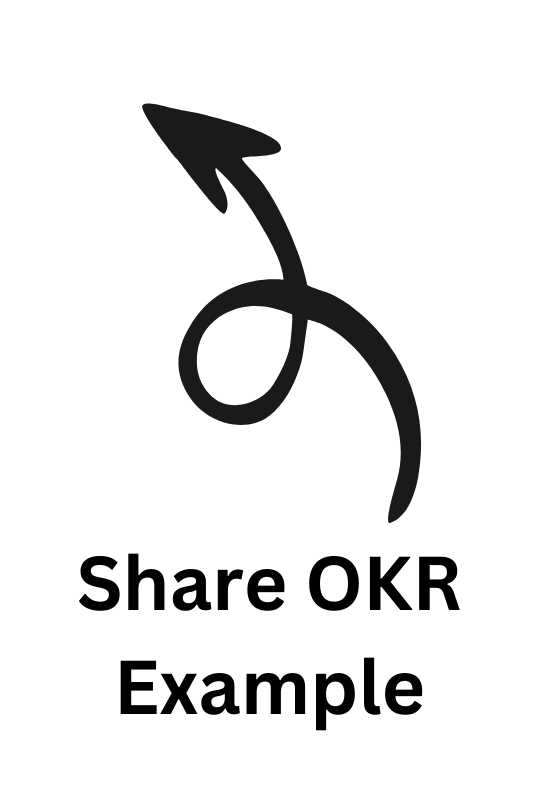As CEO, your focus is on growth, innovation, and aligning your team with the company’s vision. Objectives and Key Results (OKRs) can be a powerful tool to help you achieve these goals. By setting clear, measurable goals and monitoring progress, CEOs can create a culture of accountability and purpose throughout their organization. In this blog, we explore 10 OKR examples for CEOs, designed to drive company growth, inspire innovation, and ensure every team is headed in the same direction. Let’s get involved here!
Strategic OKR Examples 1
To establish a future-proof and scalable business model through digital transformation, the goal is to modernize key operational systems, diversify revenue streams, and enhance customer experience through data-driven insights. This involves overseeing cloud migration to improve scalability and flexibility.
Expanding digital revenue channels will capitalize on new market opportunities, while AI-driven insights will lead to improved customer satisfaction and retention. These steps will ensure the organization’s long-term competitiveness in a rapidly changing digital landscape.
Objective: Establish a Future-Proof and Scalable Business Model Through Digital Transformation
- Key Result 1: Complete 100% cloud migration for all critical business systems
- Key Result 2: Achieve a 30% increase in digital revenue through expanding digital sales channels
- Key Result 3: Improve customer satisfaction by 15% through the implementation of AI-driven insight
Strategic OKR Examples 2
To accelerate revenue growth and enhance market leadership, the goal is to drive significant financial gains and strengthen the company’s position in the market. This involves achieving 20% year-over-year revenue growth, which will demonstrate the company’s ability to scale and capitalize on market opportunities.
Increasing market share in core segments by 15% will reinforce the company’s dominance in key areas, further solidifying its leadership status. Securing three major strategic partnerships that contribute to a 10% revenue uplift will open new avenues for growth and expand the company’s reach.
These efforts will collectively accelerate revenue growth, reinforce the company’s market leadership, and position the organization for sustained success.
Objective: Accelerate Revenue Growth to Enhance Market Leadership
- Key Result 1: Achieve a 20% year-over-year revenue growth.
- Key Result 2: Increase market share in core segments by 15%.
- Key Result 3: Secure 3 major strategic partnerships contributing to a 10% revenue uplift.
Strategic OKR Example 3
To enhance operational efficiency across the organization, the goal is to streamline processes, reduce costs, and improve the timeliness and effectiveness of operations. This involves reducing overall operational costs by 10%, which will free up resources for reinvestment and improve the organization’s financial health.
Achieving a 95% on-time delivery rate for all projects ensures that the organization meets its commitments consistently, enhancing customer satisfaction and trust. Implementing process automation across key departments will result in a 20% efficiency gain, allowing the organization to operate more smoothly and with greater productivity.
These efforts will drive significant improvements in operational efficiency, enabling the organization to perform at its best while reducing waste and delays.
Objective: Enhance Operational Efficiency Across the Organization
- Key Result 1: Reduce overall operational costs by 10%.
- Key Result 2: Achieve a 95% on-time delivery rate for all projects.
- Key Result 3: Implement process automation across key departments, resulting in a 20% efficiency gain.
See How the Worxmate’s OKR Software Can Help You Drive Growth.
Book a Demo
Strategic OKR Example 4
To strengthen our global presence and expand market reach, the focus is on growing the company’s international footprint and enhancing its global market position.
This involves entering new international markets to diversify revenue streams and tap into new opportunities. Additionally, increasing the share of revenue generated from international markets will reflect these expansion efforts’ success.
Establishing local partnerships in each new market will facilitate smoother entry and operations, leveraging local expertise and networks. These steps will collectively build a stronger global presence and broaden the company’s market reach, driving sustained growth and success.
Objective: Strengthen Global Presence to Expand Market Reach
- Key Result 1: Enter 3 new international markets.
- Key Result 2: Increase international revenue contribution to 40% of total revenue
- Key Result 3: Establish local partnerships in each new market by.
Strategic OKR Example 5
To foster a high-performance culture aligned with the company vision, the goal is to create an environment where employees are highly engaged, and their work is closely connected to the organization’s strategic objectives. This involves ensuring that most employee goals are aligned with the company’s vision, helping to drive cohesive efforts towards shared goals.
Additionally, increasing employee productivity through targeted initiatives will enhance overall performance and efficiency. Improving employee satisfaction will ensure that the work environment is positive and supportive, contributing to a motivated and high-performing workforce. These efforts will collectively build a strong, performance-oriented culture that supports the company’s vision and objectives.
Objective: Foster a High-Performance Culture Aligned with Company Vision
- Key Result 1: Achieve a 90% alignment rate of employee goals with company vision.
- Key Result 2: Increase employee productivity by 15% through targeted initiatives.
- Key Result 3: Improve overall employee satisfaction to 85%
Strategic OKR Example 6
To drive company-wide innovation and accelerate digital growth, the goal is to integrate cutting-edge technologies, streamline operations, and enhance the customer journey. This includes adopting automation across key departments to boost productivity and reduce operational costs. The company will also launch new digital products and services to capture emerging market demands.
Enhancing customer engagement through personalized digital experiences will improve retention and loyalty, fostering long-term growth and market leadership.
Objective: Accelerate Innovation and Digital Growth Across the Organization
- Key Result 1: Implement automation in 50% of core business processes to reduce operational costs by 15%
- Key Result 2: Launch 2 new digital products or services, contributing to a 20% increase in digital revenue
- Key Result 3: Achieve a 25% increase in customer engagement through personalized digital experiences
Strategic OKR Example 7
To solidify the company’s market leadership and drive strategic growth, the goal is to set a clear long-term direction by expanding into new markets, enhancing competitive positioning, and fostering strategic alliances.
This involves aligning all business units to a unified growth strategy, optimizing resource allocation, and ensuring the company remains agile in responding to market changes. Strategic partnerships and investments in emerging technologies will be key drivers for sustained success.
Objective: Strengthen Strategic Positioning and Drive Long-Term Growth
- Key Result 1: Develop and execute a 5-year strategic growth plan, targeting expansion into 2 new international markets
- Key Result 2: Secure 3 strategic partnerships with industry leaders to enhance competitive advantage and innovation
- Key Result 3: Achieve a 10% increase in market share through strategic initiatives focused on competitive differentiation
Strategic OKR Example 8
To enhance customer-centricity and increase customer loyalty, the goal is to significantly improve the overall customer experience and strengthen their connection with the company. This involves making meaningful improvements based on customer feedback and satisfaction metrics.
The focus will be on boosting the Net Promoter Score (NPS), which reflects how likely customers are to recommend the company to others, signaling their satisfaction. Additionally, efforts will be made to increase the rate of repeat customers, indicating stronger loyalty and satisfaction with the company’s products or services.
Implementing a company-wide customer feedback system will ensure that a high percentage of customer input is collected and utilized effectively to drive improvements. These initiatives will collectively foster a more customer-focused culture, enhancing satisfaction and loyalty.
Objective: Enhance Customer-Centricity to Increase Customer Loyalty
- Key Result 1: Improve Net Promoter Score (NPS) by 15 points.
- Key Result 2: Achieve a 25% increase in repeat customer rate.
- Key Result 3: Implement a company-wide customer feedback system with a 90% response rate.
Strategic OKR Example 9
To ensure the company’s long-term success and adaptability in a competitive landscape, the goal is to establish a robust strategy that drives innovation, diversification, and market expansion.
This includes setting a clear roadmap for growth, optimizing business models, and building resilience to market fluctuations. Strategic investments in high-growth areas and proactive risk management will be critical for maintaining the company’s competitive edge.
Objective: Create and Execute a Strategic Roadmap for Sustainable Growth and Market Expansion
- Key Result 1: Launch a new business unit focused on high-growth markets, contributing to 20% of overall revenue
- Key Result 2: Complete a comprehensive review and restructuring of the company’s business model, enhancing profitability by 15%.
- Key Result 3: Establish a risk management framework to mitigate potential market disruptions, reducing operational risks by 25%
Strategic OKR Example 10
To ensure the company’s strategic vision is executed successfully, the focus is on effectively implementing and monitoring the key components of the strategic plan. This involves achieving high completion rates for critical strategic initiatives outlined in the annual plan, ensuring that key goals are met within the designated timeframe.
Additionally, maintaining strong alignment between the company’s strategic vision and operational execution is crucial, with the aim for nearly all departments to meet their strategic objectives.
Regular bi-annual reviews with the executive team will be conducted to assess the progress of the strategic roadmap and make necessary adjustments based on market trends and evolving business goals. These steps will help drive successful execution of the company’s strategic vision and ensure it remains aligned with both internal and external factors.
Objective: Ensure the Company’s Strategic Vision is Executed Successfully
- Key Result 1: Achieve 95% alignment of departmental and business unit OKRs with the company’s strategic objectives, reviewed and validated quarterly.
- Key Result 2: Deliver 100% of high-priority strategic initiatives on time, with a minimum 20% return on investment, by the end of the fiscal year.
- Key Result 3: Increase cross-functional collaboration effectiveness by 40%, as measured by project completion success rates and stakeholder satisfaction scores.As a CEO, driving growth and innovation starts with clear, actionable goals. With Worxmate, the best OKR software, you can seamlessly set, track, and align strategic OKRs to achieve your vision. Empower your teams, monitor progress in real-time, and foster a culture of accountability and innovation.



